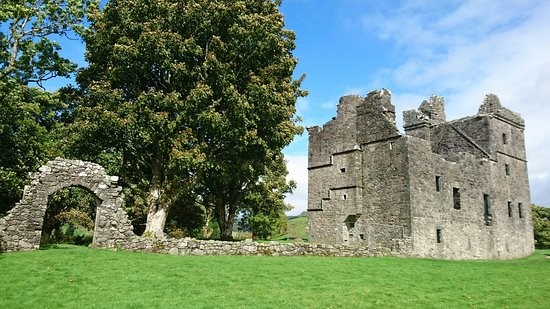Overview – Carnasserie Castle: on the A816, 2 mile north of Kilmartin. The property was held by the MacLachlans in 1436, then by the Campbell Earl of Argyll but was given in 1559 to John Carswell, who built the present castle. Carswell published the first ever book in Gaelic in 1567, the Gaelic version of the Book of Common Order. He was Rector of Kilmartin, where he also had a castle (Kilmartin Castle), Chancellor of the Chapel-Royal at Stirling. He was made Bishop of the Isles in 1566 by Mary, Queen of Scots and had a substantial income. On his death in 1572, he was buried doon the road at Ardchattan, the castle passed to the Earl of Argyll and sold in 1643 to Sir Dugald Campbell, 3rd Baronet of Auchinbreck. In 1690, he petitioned Parliament claiming Maclean clansmen burnt Carnasserie Castle, stole 2,000 cattle and murdered his uncle Alexander Campbell of Strondour (see next paragraph).
1685: During Argyll’s rebellion against James VII, Carnasserie is captured, partly blown up by a Royalist force commanded by MacLean of Torloisk and left as a burnt-out shell. In 1690, Campbell of Auchinbreck petitioned for £20,000 Scots in compensation for the murder of his uncle during the siege and the damage caused to Carnasserie, still regarded as one of the finest houses in Argyll. No attempts are made to renovate the castle, and Auchinbreck is ruined as a result of the Marquis’ revolt.
The history bits; Built between 1565 and 1572, Carnasserie stands on the summit of a ridge at the upper end of Kilmartin Glen, on the road between Lochgilphead and Oban. The castle occupies the site of an earlier medieval castle and there is a possible early medieval defended site near the castle. Carnasserie was built as a residence for Bishop John Carsewell, the first Protestant Bishop of the Isles, a close associate for the Campbell 5th Earl of Argyll who granted the lands and castle of Carnasserie to his chaplain in 1559. According to a 15th-century charter, an earlier castle stood in the immediate vicinity, occupied by the MacLachlans of Strathlachlan, and it is likely that the earlier structure provided the masonry for Bishop Carsewell’s new residence. Although the outer walls remain largely undamaged, Carnasserie was never rebuilt and the Auchinbrecks eventually went bankrupt. In the 19th century the estate was sold to the Malcolms of Poltalloch, who also own nearby Duntrune Castle. Today the castle and its’ surroundings are protected as a scheduled monument in the care of Historic Environment Scotland. The castle is a 5-storey tower house, with a three storey hall house of substantial accommodation. At basement level are the remains of cellars and a kitchen with a large fireplace and water inlet. Above this is the large hall, a wide stair rises from the entrance to the hall, in a small tower. A smaller stair leads from the hall to the parapet walk on three sides of the tower house. Upper rooms would have bedrooms. The exterior displays “double keyhole” gun loops, as well as decorative string courses and corbelling. Over the entrance are the arms of the 5th Earl of Argyll with the Gaelic motto DIA LE UA NDUIBHNE, “God be with O’Duine”, referring to the ancestors of Clan Campbell. An archway bears the inscription SDC LHL 1681, for Sir Duncan Campbell, 4th Baronet and Lady Henrietta Lindsay, whose support for Argyll’s uprising led to the castle’s destruction.

